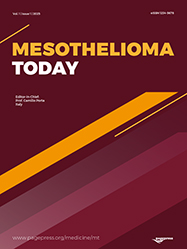
About the Journal
Mesothelioma is a type of cancer that occurs in the mesothelium, the protective layer of tissue protecting most internal organs. Pleural mesothelioma, the most common variant, is a malignancy that impacts the tissue encasing the lungs.
Chest pain, dyspnoea, unexplained weight loss, fatigue, and subcutaneous nodules on the chest are symptoms potentially linked to mesothelioma. Additional symptoms encompass lethargy. Various forms and stages of cancer might elicit these symptoms to present in diverse manners.
In several instances, malignancies such as mesothelioma are induced by exposure to asbestos, a fibrous mineral that was often employed in the manufacture of construction materials until recently. Asbestos exposure is predominantly encountered in occupational settings, including building sites, shipyards, and factories. Moreover, asbestos exposure can occur through secondary contact, which happens when an individual interacts with someone employed in asbestos-related activities.
This publication aims to be a crucial reference for medical professionals and researchers engaged in the study and treatment of mesothelioma and other asbestos-related diseases.
____________________________________________________________________________________________________
This new journal is completely Open Access and free of charge: no cost for either submitting or publishing articles.


